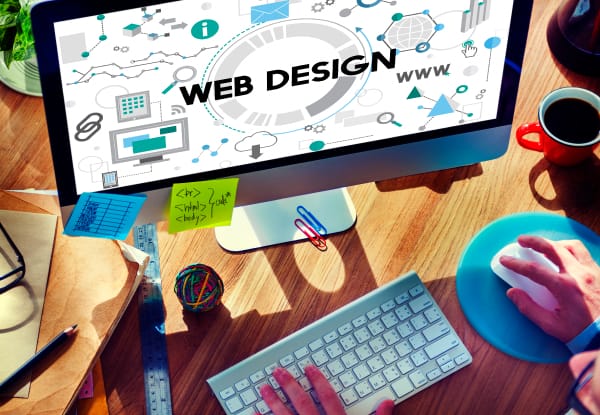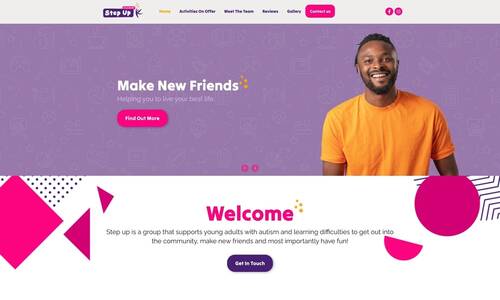The Ultimate Guide to Website Design: Tips for Creating Stunning Websites
The Ultimate Guide to Website Design: Tips for Creating Stunning Websites
Blog Article
Modern Web Site Layout That Records Interest and Converts
In a progressively electronic landscape, modern web site design has actually emerged as a pivotal variable in recording customer interest and driving conversions. By tactically employing aesthetic pecking order, receptive designs, and engaging interactive elements, developers can produce experiences that not only bring in visitors but additionally assist in significant interactions. Efficient call-to-action techniques play a crucial role in assisting users toward wanted outcomes. As we check out these crucial elements, it becomes clear that comprehending their interaction can substantially impact a web site's efficiency and customer satisfaction. What are the crucial components that absolutely make a difference?
Importance of Visual Power Structure
Aesthetic power structure is a vital component in internet site layout, as it guides users' attention and improves their total experience. By tactically organizing content, developers can guide customers to one of the most essential details first, thus boosting interaction and enhancing usability. Effective visual hierarchy uses different techniques, including size, comparison, spacing, and color. Bigger elements normally attract the eye, while contrasting shades can emphasize key messages, making them attract attention among more restrained parts.
Including a sensible circulation in material setup is essential; for example, positioning the most essential info on top of a page fosters immediate acknowledgment. In addition, regular use of typography, such as differing font dimensions and styles, aids develop a clear material framework. This organization not only aids in navigating but also develops trust fund, as users feel a lot more comfy when they can easily locate what they are seeking.
Eventually, a well-executed visual hierarchy not only boosts aesthetic allure but additionally significantly affects individual behavior. By focusing on necessary components and making sure a smooth experience, developers can properly convert site visitors right into customers, strengthening the relevance of this foundational design principle in modern internet site advancement.
Responsive Design for All Instruments
Developing a smooth experience across various tools is essential in today's electronic landscape, where customers access websites from desktop computers, smartphones, and tablets alike. Receptive style is an important approach that guarantees websites adjust fluidly to various screen sizes, resolutions, and orientations. By employing adaptable grids, photos, and CSS media questions, developers can develop layouts that keep visual stability and performance, no matter the device being utilized.
The value of receptive layout expands beyond aesthetics; it straight affects customer interaction and conversion rates. A site that functions well on all gadgets urges longer visits and decreases bounce prices, as users are a lot more likely to communicate with material that is easy to browse. Moreover, online search engine, especially Google, focus on mobile-friendly websites in their positions, making receptive design an essential part of seo (SEO)
Incorporating responsive style not only boosts individual experience however likewise simplifies the development procedure. By developing a solitary website that functions throughout devices, organizations can conserve time and sources contrasted to developing separate mobile and desktop computer variations. Eventually, receptive layout is a fundamental technique for modern-day internet site layout, making certain access and contentment for all users, despite their device.
Involving Interactive Aspects
While a responsive style lays the groundwork for a useful site, including appealing interactive components is essential for capturing individual focus and promoting much deeper links. Website Design. Interactive components, such as animations, quizzes, and clickable infographics, develop a much more dynamic individual experience, motivating visitors to spend even more time on the website
Including interactive features can additionally assist users through facility details, making it simpler to absorb material. For instance, interactive sliders can highlight product variants, while ingrained videos can supply presentations or testimonials that resonate more than static images or text. Gamification methods, like benefits for engaging or completing jobs with web content, can enhance individual motivation and retention.
Efficient use interactive components not only enriches the individual experience yet can likewise result in higher conversion prices. By making communications interesting and satisfying, services can grow a sense of commitment and count on with their audience. Nonetheless, it is important to balance interactivity with performance; extremely complicated attributes might impede site speed, adversely impacting individual fulfillment. Eventually, incorporating well-designed interactive elements can dramatically raise a site's efficacy, driving involvement and conversions in today's competitive electronic landscape.
Streamlined Navigating Practices
Efficient navigating is a cornerstone of any type of effective website, as it straight influences customer experience and content accessibility. Streamlined navigating methods guarantee that users can conveniently situate info, improving their interaction with the website. A well-structured navigation food selection must be basic and instinctive, typically including a restricted number of main classifications to prevent overwhelming visitors.
To accomplish structured navigation, developers should prioritize an ordered structure that rationally arranges web content. Applying breadcrumb tracks can give individuals with context concerning their present location within the site, permitting seamless backtracking. Furthermore, using drop-down menus can efficiently save area while still providing accessibility to subcategories.
Responsive style is vital, as navigating ought to be practical across all tools (Website Design). Mobile users, in certain, benefit from touch-friendly menus and retractable areas that keep use without endangering visual appeals

Effective Call-to-Action Methods
A well-crafted call-to-action (CTA) is important for directing individuals toward preferred outcomes on a web site, as it urges them to involve with content or make a purchase. To optimize their efficiency, CTAs need to be clear, engaging, and tactically put throughout the website.
First, utilize action-oriented language that interacts seriousness or value, such as "Obtain Started," "Sign up with Now," or "Insurance claim Your Discount rate." This language not only motivates customers however additionally sets clear assumptions about the next steps.
2nd, consider layout aspects; Website Design CTAs ought to attract attention aesthetically with contrasting shades, ample whitespace, and noticeable positioning. A switch that is easy to see and click rises the likelihood of individual communication.
Furthermore, personalizing CTAs based upon user actions or demographics can substantially enhance interaction. Tailored messages reverberate more with individuals, driving greater conversion prices.

Final Thought
These parts jointly improve customer experience, making certain that visitors continue to be involved and inspired to check out web content further. By focusing on these design concepts, businesses can dramatically improve user retention and conversion rates, inevitably leading to higher success in the digital landscape.
In an increasingly electronic landscape, modern website layout has emerged as a crucial element in catching customer focus and driving conversions.Visual power structure is an important aspect in website style, as it guides users' interest and boosts their total experience.The significance of responsive style prolongs past appearances; it directly impacts user engagement and conversion rates.Integrating responsive style not only boosts user experience but likewise improves the growth process. Inevitably, receptive design is an essential strategy for modern-day web site style, ensuring accessibility and fulfillment for all users, no matter of their tool.
Report this page